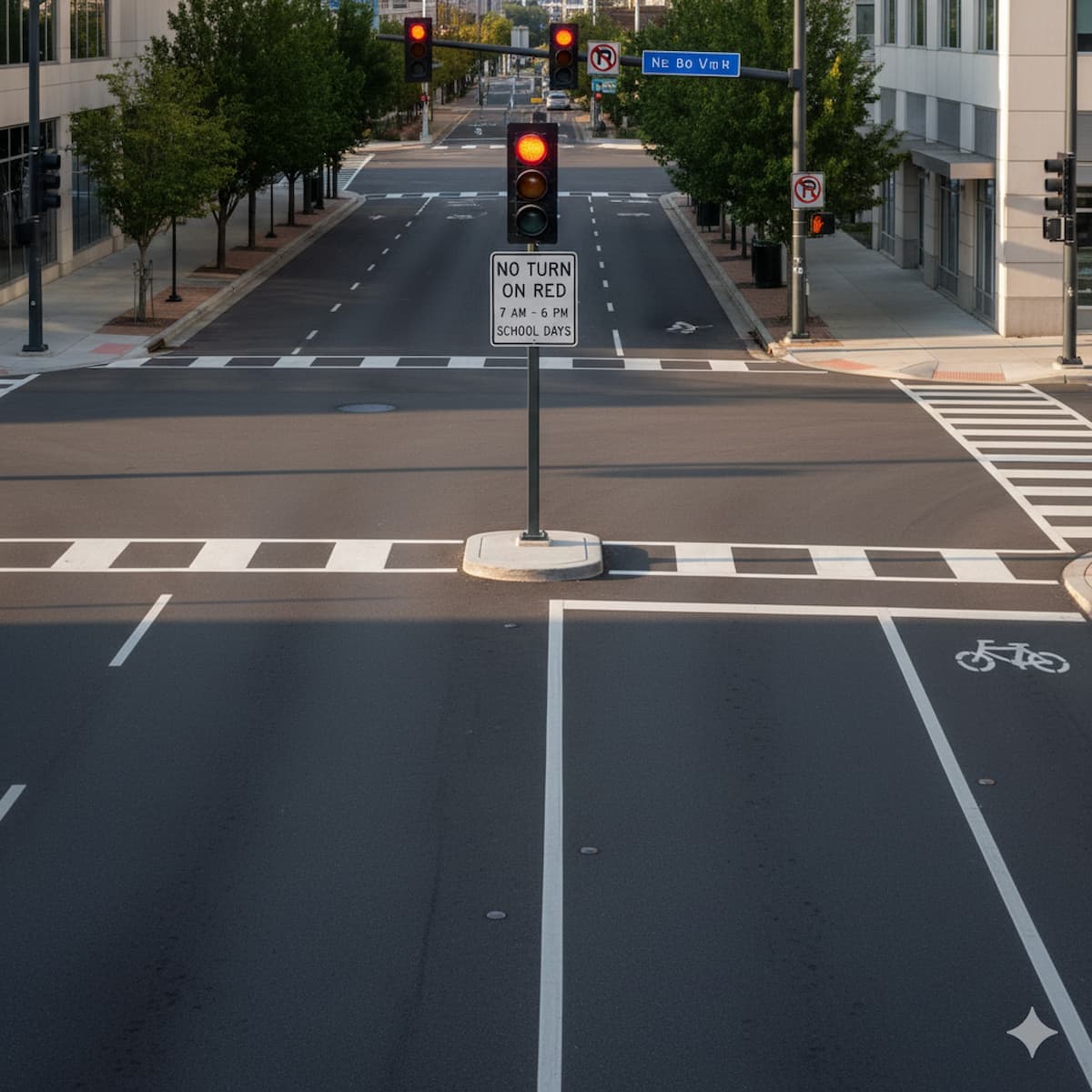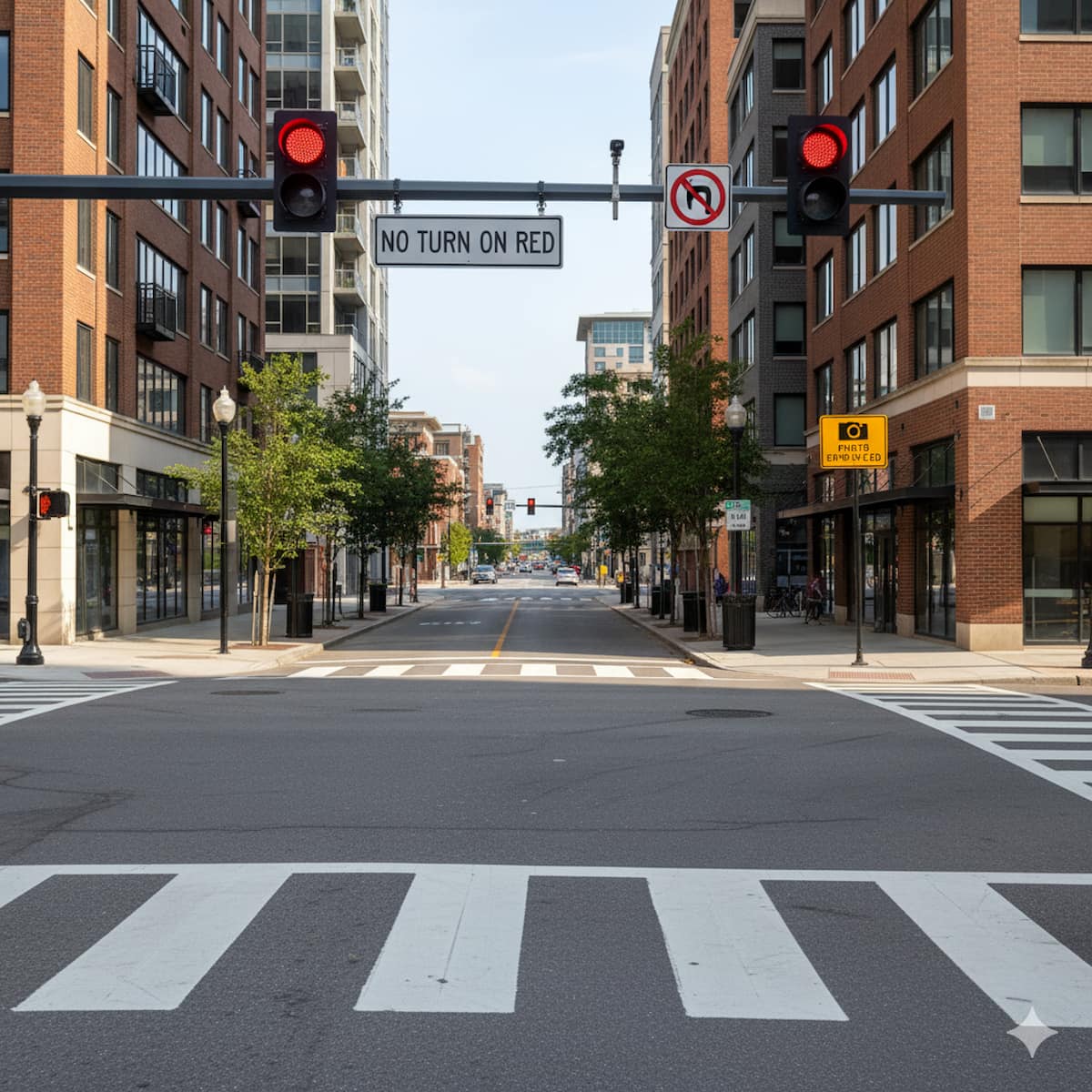
The right turn on red rule has been a standard across most U.S. states since the 1970s energy crisis, allowing drivers to turn right after stopping at a red light when safe. However, as cities prioritize pedestrian safety and cyclist protection in 2025, new restrictions, sign variations, and camera enforcement policies are reshaping when and where you can legally make this maneuver. This comprehensive guide explains the core rules, emerging city-level bans, posted sign meanings, common mistakes that trigger tickets, and state-by-state differences. For related context, see our detailed guides on right turn on red rules, crosswalk pedestrian right-of-way, and general driving rules.
Where right on red is being limited in 2025
Major metropolitan areas are implementing new restrictions on right turns on red to reduce pedestrian and cyclist injuries. Washington DC banned most right turns on red citywide in late 2024, joining New York City which has prohibited the maneuver for decades. Cities including Seattle, San Francisco, Ann Arbor, and parts of Los Angeles have added corridor-specific or intersection-level bans, especially in downtown cores, near transit stations, and around schools. These changes reflect data showing that right-turn conflicts account for a significant share of urban pedestrian crashes.
Pedestrian and cyclist priority at busy junctions
Intersections with high foot traffic—such as downtown crosswalks, university campuses, and transit hubs—now frequently display "No Turn on Red" signs. Drivers must wait for a green signal even if the intersection appears clear. Cyclists using bike lanes complicate right turns further: before initiating any turn, scan your mirrors and blind spot for cyclists traveling straight through the intersection. Many cities use leading pedestrian intervals (LPI) that give walkers a head start, requiring drivers to wait even longer before turning. Failure to yield results in citations and, increasingly, points on your driving record. Learn more about yielding protocols in our crosswalk pedestrian right-of-way guide.
Camera enforcement and signage updates
Red-light camera programs in cities across California, Arizona, Texas, Florida, and the Northeast now include right-turn violations. Cameras detect rolling stops (failing to come to a complete halt before the stop line or crosswalk) and turns made against posted "No Turn on Red" restrictions. Citations typically include a still image, video clip, and a fine ranging from $50 to $500 depending on jurisdiction. Some agencies also assess points. As camera technology improves, enforcement is expanding to cover more intersections and time-based restrictions.

Example corridors with time-of-day bans
Time-restricted signs like "No Turn on Red 7 AM – 6 PM School Days" are common near elementary and middle schools. During active hours, turning right on red is illegal regardless of traffic conditions. Outside those windows, standard right-on-red rules apply: stop completely, yield to pedestrians and oncoming traffic, then proceed when safe. Commuter corridors and downtown grids may display "No Turn on Red 6 AM – 9 AM, 4 PM – 7 PM Mon–Fri" to reduce conflicts during rush hour. Always read plaques carefully; ignorance of posted hours is not a defense.
State sources and city ordinances
Each state's vehicle code establishes baseline right-on-red rules, but municipalities can impose stricter local ordinances. Check your state's DMV or Department of Transportation website for official statute text. Major city transportation departments (DDOT in DC, SFMTA in San Francisco, SDOT in Seattle) publish maps and lists of restricted intersections. For state-specific details, visit our hubs for California, Texas, New York, and Florida.
The core right-on-red rule: stop, yield, proceed when safe
In jurisdictions that permit right turns on red, the universal requirement is a complete stopat the marked stop line, before the crosswalk, or at the edge of the intersection if no line is present. After stopping, you must yield the right-of-way to:
- Pedestrians in or approaching the crosswalk, including those using wheelchairs, canes, or guide animals
- Cyclists in bike lanes or traveling through the intersection
- Oncoming vehicles that have a green light or are already in the intersection
Only after confirming it is safe and legal may you complete the turn. Rolling through the stop—even at 2–3 mph—is a traffic violation commonly captured by red-light cameras and cited by officers.
Common mistakes that lead to tickets
Drivers frequently violate right-on-red rules in these ways:
- Rolling stops: Slowing but not coming to a full halt before the stop line or crosswalk. Cameras and officers watch for complete wheel cessation.
- Blocking the crosswalk: Stopping past the crosswalk forces pedestrians into traffic. This is a separate citable offense in many states.
- Ignoring "No Turn on Red" signs: Even a small rectangular plaque below the signal head prohibits the turn. Missing or ignoring it results in a ticket.
- Turning while pedestrians are in the crosswalk: You must wait until the crosswalk is fully clear, not just your immediate path.
- Failing to check for cyclists: Bike lanes often run to the right of your vehicle. Always shoulder-check before initiating the turn.
Sign variations: understanding "No Turn on Red" wording
Signs may read "No Turn on Red," "No Right Turn on Red," "Right Turn Prohibited on Red," or include time/day restrictions. All variations have the same legal effect: you cannot turn until the signal is green. Some jurisdictions use red-circle-with-slash symbols over a right-turn arrow, which is equally enforceable. If the sign specifies hours or days (e.g., "Except Sundays"), the restriction applies only during those periods.
Multi-lane right turns and lane discipline
When two lanes are marked for right turns (common at wide intersections), stay in your lanethroughout the turn. The inside lane turns into the inside receiving lane; the outside lane turns into the outside lane. Drifting or cutting across lanes mid-turn causes sideswipe collisions and is a citable improper turn. If both lanes face a red signal, both must stop and yield independently—one lane's movement does not authorize the other.
Special conditions: one-way streets and divided highways
Right-on-red rules typically apply equally at one-way-to-one-way and two-way intersections. However, some states also permit left turns on red from a one-way onto a one-way street after stopping and yielding. This less-common maneuver is detailed in our left on red states guide. On divided highways with frontage roads, watch for "No Turn on Red" restrictions at freeway on-ramps and off-ramps where merging conflicts are high.
State-by-state differences and verification resources
While right on red is legal in all 50 states (after a complete stop and yield), local jurisdictions overlay their own rules:
- New York City: Blanket prohibition on right turns on red unless a sign explicitly permits it.
- Washington DC: Citywide ban implemented in late 2024; exceptions posted at select intersections.
- California: State law allows right on red, but cities like San Francisco and Los Angeles restrict it at hundreds of intersections. Check local signage.
- Texas: Generally permissive; restrictions appear mainly in downtown Dallas, Austin, and Houston.
- Florida: Allowed statewide with exceptions in Miami, Tampa, and Orlando school zones.
For official statutes, visit your state's DMV website or explore our state-specific pages linked throughout this article.
How to stay compliant when traveling across state or city lines
When driving in unfamiliar jurisdictions, adopt these practices:
- Read every sign: Don't assume the rule from your home state applies elsewhere.
- Default to caution: If no sign is visible but the area is pedestrian-heavy, wait for green.
- Use GPS apps: Some navigation apps flag camera-enforced intersections and no-turn zones.
- Check city transportation websites: Major cities publish lists of restricted intersections.
Penalties, points, and insurance impacts
Fines for illegal right-on-red turns range from $50 in rural counties to $500+ in major cities with camera programs. Most states also assign points to your driving record—typically 1 to 3 points, which can increase insurance premiums by 10–30% depending on your insurer and prior record. Repeat violations or turns that cause crashes may result in additional charges (reckless driving, failure to yield) and higher penalties.
Contesting a camera ticket: what you need to know
If you receive a camera-issued citation, review the evidence packet (photo, video, date, time, location). You can contest if:
- The sign was missing, obscured, or non-compliant at the time of the alleged violation
- You were not the driver (some states allow registered-owner defenses)
- The camera malfunctioned or the timestamp is incorrect
Prepare documentation (photos of the intersection, witness statements) and follow your jurisdiction's administrative hearing process. Success rates vary; consult local traffic attorneys if the fine or points jeopardize your license.
Future trends: adaptive signals and all-red pedestrian phases
Cities are testing adaptive signal systems that adjust timing based on real-time pedestrian and bike volumes, sometimes eliminating permissive right-on-red windows entirely during peak walking periods.All-red pedestrian scrambles—where all vehicle movements stop while pedestrians cross in any direction—are expanding in high-density areas. These innovations prioritize safety over vehicle throughput, signaling a long-term shift in traffic management philosophy.
Frequently asked questions
Can I turn right on red everywhere in the United States?
Most states allow right on red after a full stop and yielding to pedestrians and oncoming traffic. However, cities like New York City, Washington DC, and parts of California have implemented full or partial bans. Always check for posted "No Turn on Red" signs.
What cities banned right on red in 2025?
Several major cities have restricted or banned right turns on red to protect pedestrians and cyclists. Washington DC implemented a comprehensive ban in 2024, and cities like Seattle, San Francisco, and Ann Arbor have added restrictions at high-traffic intersections. Camera enforcement is expanding in these areas.
Do I have to stop before turning right on red?
Yes. A complete stop at the stop line or before the crosswalk is required. Rolling through is illegal and can result in a ticket, especially at camera-enforced intersections. After stopping, you must yield to pedestrians and oncoming traffic.
Can I get a camera ticket for right turn on red?
Yes. Red-light cameras in many jurisdictions now cite rolling right turns, failure to stop before the crosswalk, and turns made where "No Turn on Red" signs are posted. Camera enforcement is increasing nationwide, especially in pedestrian-heavy areas.
What does "No Turn on Red 7 AM - 6 PM" mean?
Time-based restrictions prohibit right turns on red during specified hours, typically around schools, pedestrian zones, or rush-hour corridors. Outside those hours, you may turn right on red after stopping and yielding.
This article summarizes common rules. Always consult your state statute and posted signs for the most current information.